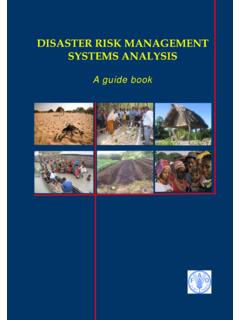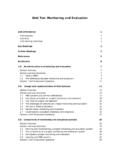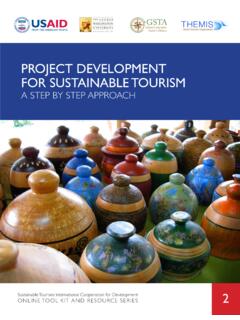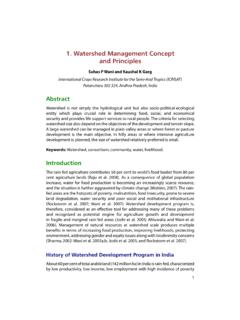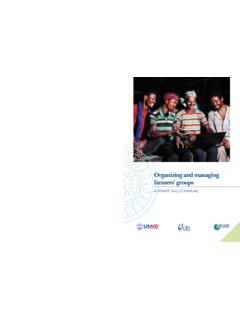Transcription of Strategies for reducing vulnerability and building ...
1 1 Strategies for reducing vulnerability and building resilience to environmental and natural disasters in developing countries Moushumi Chaudhury, PhD World Resources Institute Written for Expert Group Meeting on Strategies for Eradicating Poverty to Achieve Sustainable Development for All, New York, May 8-11, 2017 United Nations Department of Economic and Social Affairs, Division of Social Policy and Development 1. Introduction Climate change is today s biggest threat to development and disproportionately affects poor and vulnerable people. The Intergovernmental Panel on Climate Change (2015) predicts that by 2100, climate change is expected to increase the number of poor people in both developed and developing countries, jeopardizing sustainable development. Numerous reasons exist as to why poverty still exists but one major reason is the increasing number of environmental and natural disasters people will face.
2 The frequency and intensity of natural disasters associated with climate change disproportionally reduces the ability of the poor compared to the non-poor to cope with disasters because they are more vulnerable to climate shocks, they lack finance and alternative livelihoods , have limited social safety nets and access to technologies to help them adapt to climate change. Climate shocks and stresses keep or bring households into poverty because the poor are overexposed to impacts of climate change, which can cause loss of assets and production, increase in vector borne diseases, and food price shocks (World Bank 2016, 2017). Climate change will continue to threaten human well-being and undermine progress towards reducing poverty unless it is well integrated into development agendas. The United Nations recognizes the threat that climate change imposes and has included Target under Sustainable Development Goal (SDG) 1 to end poverty in all its forms everywhere.
3 Target states that by 2030, the world must build the resilience of the poor and those in vulnerable situations and reduce their exposure and vulnerability to climate related extreme events and other economic, social, and environmental shocks and disasters (UN 2016c). Additionally, Goal 13 focuses purely on climate change calling on urgent action to combat climate change and its impacts. Target states that we must strengthen resilience and adaptive capacity to climate related hazards and natural disasters in all countries. Countries around the world are already beginning to incorporate issues of vulnerability , adaptation and resilience into their nationally determined contributions towards climate change. Prior to the landmark Paris Agreement, signed in April 2016 by 175 Member States, over 70 per cent of parties to the UN Framework Convention on Climate Change included an adaptation component in their plans for climate action (UN 2016b).
4 This suggests that more and more countries are serious about moving their country s development trajectory to development that is climate informed, which places climate change at the center to reduce vulnerability , address poverty, and build resilience. This paper aims to highlight Strategies that adaptation planners can use to help people adapt to climate change by reducing vulnerability and building resilience, and hence, help meet Targets and Adaptation calls for human-driven adjustment to economic, social, and environmental systems in response to climate impacts. By implementing adaption options, vulnerability , which is the degree of susceptibility to an adverse effect of climate change, can be reduced (Adger 2006). reducing 2 vulnerability by implementing adaptation options leads to building resilience. Resilience is the ability of a system to absorb climate induced shocks or disturbances while either retaining the same basic structure and ways of functioning or bouncing back better.
5 The central element required to building resilience is boosting adaptive capacity of people or the ability to adjust to a climate stimuli (ODI 2010). The Strategies described in section 2 are based on adaptation practices that have been applied in various contexts, and have proven to be successful in reducing vulnerability , building resilience, and addressing poverty. Applying the Strategies in this paper by integrating them into climate change and development projects and programs can help to protect lives and livelihoods . It should be noted, however, that this paper does not offer or advocate for any specific adaptation solutions or options because options are context specific. Instead, this paper focuses on five Strategies that can be considered as building blocks before implementing any specific adaptation option. The five Strategies include conducting a vulnerability assessment; incorporating uncertainty into resilience planning; engaging socially marginalized groups in decision making; monitoring, evaluating, and learning; and scaling adaptation options.
6 To illustrate how these Strategies have been applied around the world, this paper provides examples that describe how the Strategies have been applied and have helped to reduce vulnerability and build resilience. The paper concludes in Section 3 with recommendations on applying the Strategies to reduce vulnerability and build resilience so that poverty can be tackled within the context of 2030 Agenda for Sustainable Development. 2. Strategies to Reduce vulnerability , Address Poverty, and Build Resilience This section highlights Strategies that have been tried and tested in various contexts that can help reduce vulnerability and build resilience. They have been derived from climate change adaptation literature and are referred to as good adaptation practices. This section also provides examples to illustrate how these Strategies have been applied to demonstrate how poor people have reduced their vulnerability and build resilience.
7 (a) Strategy 1: Conduct vulnerability Assessments to Develop Resilience Plans The poor are highly vulnerable to impacts of natural disasters. The Intergovernmental Panel on Climate Change defines vulnerability as the degree to which a system is susceptible to, or unable to cope with, adverse effects of climate change (McCarthy et al. 2001). vulnerability is comprised of three components: degree to which a system experiences environmental and socio-political stress (exposure), degree to which a system is modified by the stress (sensitivity), and the ability of a system to evolve to accommodate environmental hazards or policy change (adaptive capacity) (Adger 2006). Figure 1 below shows that the poor are much more exposed and vulnerable to natural disasters. 3 Figure 1: Poor People and Natural Disasters Source: World Bank 2016 To reduce vulnerability , it is important to first understand what vulnerabilities exist by conducting a vulnerability assessment.
8 Often, in practice a vulnerability assessment primarily focusses on exposure and sensitivity of biophysical systems. Comprehensive vulnerability assessments, however, go beyond measuring biophysical exposure to climate change impacts. They include assessment of climate risks; social, economic, and ecosystem vulnerability ; assessment of people s capacity to cope with and plan for natural disasters; and institutional mapping that identifies organizations who can help manage climate risks (CARE 2016). They specifically incorporate socioeconomic vulnerabilities of people and identify those who are resource poor so that they can be targeted to build their adaptive capacity. Therefore, vulnerability assessments include economic research on how climate impacts poverty and wealth, and gender analysis to assess the adaptive capacity of men and women. For vulnerability assessments to be effective in reducing vulnerability , they need have credible scientific information, and be salient to local level adaptation planners and beneficiaries of adaptation interventions to be effective (Chaudhury et al.)
9 2014). For instance, pastoralists in Northern Kenya face drought quite often. To help pastoralists reduce their vulnerability and build their resilience, the International Institute for Environment and Development (IIED 2013) acted as a knowledge broker, working jointly with scientists conducting the vulnerability assessment to inform local climate planning to help pastoralists adapt to climate change. IIED also worked with NGOs in Northern Kenya to ensure that scientists were incorporating views of vulnerable pastoralists. Scientists collaborated with local level planners to apply different methods to collect information for the vulnerability assessment ranging from community resource mapping, focus group discussions, and forecast workshops. Downscaled climate projections were also integrated into the assessment. IIED and its NGO partners helped scientists and pastoralists to work together to identify who is socially and economically vulnerable and adaptive capacity measures needed by using scientific information and incorporating local understanding of who is vulnerable.
10 The vulnerability assessment conducted was highly effective since it allowed for consensus between pastoralists and government officials as to where funds should be allocated to implement adaptation options to reduce vulnerability . The assessment is also included in the Kenyan National Adaptation Plan and County Livestock Strategy, and is being used to streamline scaling-up adaptation activities in neighbouring counties. These achievements have been highlighted in Kenya s National Climate Change Strategy. 4 (b) Strategy 2: Incorporate uncertainty in resilience planning When planning for adaptation, weather information is crucial. For instance, it is important for a farmer to know when the rain will arrive, which will determine when crops are planted and harvested. Weather information is provided within a short timescale, that predicts what could happen within the next five days.










